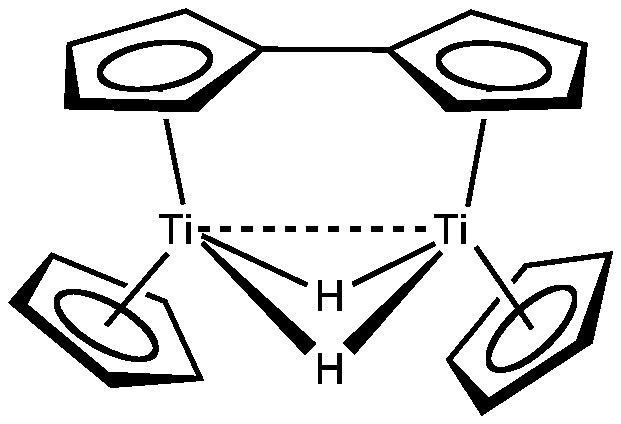 | ||
Organotitanium compounds in organometallic chemistry contain carbon-to-titanium chemical bonds. Organotitanium chemistry is the science of organotitanium compounds describing their physical properties, synthesis and reactions. They are reagents in organic chemistry and are involved in major industrial processes.
Contents
Brief history
Although the first attempt to create an organotitanium compound dates back to 1861, it took until 1953 for the first synthesis of such a compound. In that year titanium phenyltriisopropoxide was prepared from titanium isopropoxide, phenyllithium, and titanium tetrachloride. Titanocene dichloride was discovered in 1954, and the first methyltitanium compounds were produced in 1959. Ziegler-Natta catalysts utilizing titanium-based catalysts soon followed as a major commercial application for which the 1963 Nobel Prize in Chemistry was awarded.
Properties
The titanium electron configuration ([Ar]3d24s2) resembles that of carbon and like carbon the +4 oxidation state dominates and like carbon compounds, those of titanium have a tetrahedral molecular geometry. Thus, the boiling points of TiCl4 and CCl4 are very similar. Titanium is however a much larger element than carbon, reflected by the Ti-C bond lengths being about 30% longer, e.g. 210 pm in tetrabenzyltitanium vs a typical C-C bond of 155 pm. Simple tetraalkyltitanium compounds however are not typically stable, owing to the large size of titanium and the electron-deficient nature of its tetrahdral complexes. More abundant and more useful than the simple tetraalkyl compounds are organic derivatives with alkoxide and cyclopentadienyl coligands. Titanium is capable of forming complexes with high coordination numbers.
In terms of oxidation states, most organotitanium chemistry, in solution at least, focuses on derivatives of Ti(IV). Ti(II) compounds are rarer, examples being titanocene dicarbonyl and Ti(CH3)2(dmpe)2. [Ti(CO)6]2− is formally a complex of Ti(-II). Although Ti(III) is involved in Ziegler-Natta catalysis, the organic derivatives of Ti(III) are not common.
The oxidation states −1, 0, +1 are also known in organotitanium compounds.
Due to the low electronegativity of titanium, Ti-C bonds are polarized toward carbon. Consequently, alkyl ligands in many titanium compounds are nucleophilic. Titanium is characteristically oxophilic, which presents challenges to handling these compounds, which require air-free techniques. On the other hand, high oxophilicity means that titanium alklyls are effective for abstracting or exchanging organyl ligands for oxo groups, as discussed below.
Chemistry
Organotitanium compounds are important reagents in organic chemistry. Some reagents include the following.
Titanocene derivatives
A particularly rich area of organotitanium chemistry involves derivatives of titanocene dichloride. Early work on "titanocene" itself eventually revealed that this species was a fulvalene dimer complex. This discovery led to many innovations on cyclopentadienyl complexes of titanium. Only in 1998 was a true titanocene derivative identified, the paramagnetic species (C5Me4SiMe3)2Ti.
Tebbe's reagent (1978) is prepared from titanocene dichloride and trimethylaluminium. It is used as a methylenation agent for carbonyl compounds (converstion of R2C=O to R2C=CH2). It is an alternative for Wittig reagents when the carbonyl group is sterically challenged or when it easily forms the enol. Tebbe's reagent adds simple alkenes to give titanocyclobutanes, which can be regarded as stable olefin metathesis intermediates. These compounds are reagents in itself such as 1,1-bis(cyclopentadienyl)-3,3-dimethyltitanocyclobutane, the adduct of Tebbe's reagent with isobutene catalysed with 4-dimethylaminopyridine.
The Petasis reagent or dimethyl titanocene (1990) is prepared from titanocene dichloride and methyllithium in diethyl ether. Compared to Tebbe's reagent it is easier to prepare and easier to handle. It is also a methylenation reagent.
